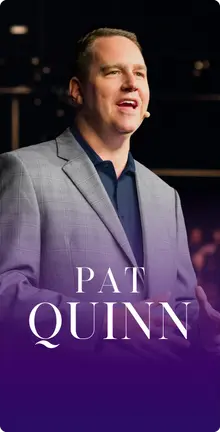Welcome, Mark, it’s great to have you on this podcast.
I can hardly wait to find out what we are talking about.
Me too. I think it might cover some topics such as PTSD, anger management, and listening; some of the topics in your books. We could probably go into those areas.
Before we do, how about you just share with our listeners just a fun, interesting anecdote, something that is a little unexpected about yourself?
When you create ‘gotta have it’ in customers and clients, you don’t have to sell them. They just signed up.
Let’s see. Well, this is kind of an upcoming anecdote. I’ve been giving talks at innovation conferences and digital media conferences and to CEO and tech round tables on how to create ‘gotta have it,’ the secret of Steve Jobs. Because Steve Jobs and Apple knew how to create a ‘gotta have it’ experience. When you create ‘gotta have it’ in customers and clients, you don’t have to sell them. They just signed up.
Recently, I gave this presentation, and someone said, “I think you have figured out, also, the formula that ISIS uses to radicalize vulnerable teenagers.” So, I’m actually meeting next week with one of the world’s top anti-terrorism people to discuss that. So I think that’s kind of interesting to discuss. It’s also, I think, a lesson of sometimes you think you have something, and when you repurpose it or tweak it in a different direction, it’s amazing the kind of traction you get. That’s very interesting. I’m very excited about that.
That’s awesome. Sounds very important, too. Good luck with all that. If we were to delve into a topic that is nearest and dearest to your heart, what would that be?
I think something that’s nearest and dearest to my heart is that I try to be adaptive to the audience. So if the title of this podcast, what is it, Optimization for Geeks?
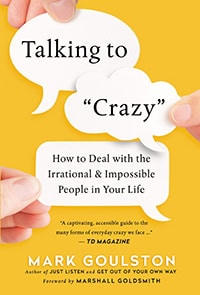
Get Yourself Optimized. It’s like a transformation process for becoming your best self. If you’re a little geeky, and you want to stay cool, geeky in a cool way, but you also want to fill out the other aspects of your life with more balance, more awesomeness; that’s what we’re about.
I think what’s near and dear to my heart is when I can accurately tune in to the audience that is likely to be listening to me. I guess my wife would say I’m more nerdy than geeky because I’m not that technological. I probably am a bit nerdy. If I were to put myself in the shoes of a geeky person who is listening to this, one of the things I might be puzzled about is my intention is never to turn off people, hurt people’s feelings, upset them, or frustrate them but I seem to do it a lot. People seem to take me the wrong way.
Basically, as a geek, I’m just trying to solve problems. I’m just trying to make the world better. I’m just trying to make the people around me better. On more than a few occasions, especially if someone around me seems emotionally upset, boy, would I try to solve them in a geek way? There’s a good chance I’m going to be sleeping in the den.
Assuming that that might apply to some of the people listening, let me try and give you some help with that, some practical help. I’ve been blessed to have 6 mentors. I’ve not been blessed to have them all pass away. My most recent mentor, who passed away, was a fella named Warren Bennis. Warren Bennis is synonymous with leadership. He may be seen as one of the top 3 people inventing the field of leadership and writing about it, and he died last August. There’s not a day that goes by that I don’t think about him and miss him. He had all these wonderful phrases. One of his, which I think is a wonderful thing to use, especially if you are a geek, and it’ll especially be easy, is a first-class noticer.
Noticing is different than looking, watching, or seeing.
Noticing is different than looking, watching, or seeing. When you look, watch, and see, you’re kind of a passive observer. You’re not particularly present. Right now, as I’m standing up in front of my office, I’m noticing my printer still has packing tape on it, and it’s 5 years old. That makes me think I must have been in a rush to get it up and going. I never noticed that before, or I would’ve taken it off.
Often technologists, engineers, and geeks, they are great at noticing things. Here is something to notice with people who, when they get emotionally upset, do not want an answer, advice, or a solution. Often when you’re dealing with someone who is emotionally upset, and they’re talking to you or venting at you, one of the reasons they’re doing that is because they’re trying to get something off their chest before they act on it. Because there’s a fear if they don’t get it off their chest verbally, they’re going to act on it and do something that they regret.
It may be because if you’re a geek, you’re a good problem solver, and you seem non-emotional, it may be that they see you as safe and solid. What they’re trying to do is displace their emotionality onto you and have you absorb it, basically, have you take all of the emotion off them without getting defensive, without throwing it back at them. If you’re able to do that without escalating or getting defensive, it will be, pardon the analogy, like they just had a high colonic of all this emotion on you. If you’re fortunate, it’ll clear their mind, be grateful that you didn’t escalate with them, and then they may be able to solve their own problem.

The problem is that when they’re doing this with you, especially if they’re aiming at you and hitting you between the eyes, it’s pretty difficult not to be defensive when someone is saying, “You’re a workaholic,” or “You’re clueless,” or “You have Asperger’s,” or “I don’t even know why I bother talking to you.” Those are not exactly compliments. When I give talks, especially at technology conferences, and people seem to like this, what I say is imagine that they’re trying to displace things onto you before they act on it. When they’re aiming it at you, they want to take away the wiggle room. They don’t want any escape because they need to get it off their chest before they do something.
Sometimes the things they are saying to you, you really get. They’re just adding more emotion to get it off their chest. Here are the steps when they’re doing it, hold a little bit of yourself back. That doesn’t mean being aloof. Say to yourself, okay, here it comes, and they’re doing this to get stuff off their chest. It’s not about me. It’s getting stuff off their chest.
Then what you do is look into their left eye and stay focused on their left eye because imagine, I don’t know if it’s exactly true, that their left eye is connected to their right brain, which is their emotional brain. So you lean in, hold onto their left eye, let’s say they say, “You’re a workaholic, you’re clueless, you don’t get anything,” they’re expecting you to escalate. Instead, pause, and in my book, Just Listen, one of the things I teach hostage negotiators, and one of the things I teach salespeople, is you want to make use of conversation deepeners.
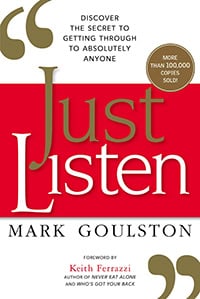
Also, something to notice, and if you notice this, you could come off as an incredible communicator when you still don’t have a clue. If you can notice when someone uses an adverb, which is their way of embellishing a verb, the way they use an adjective, which is a way of embellishing a noun when they use inflection, which is a way of embellishing a phrase, or hyperbole, which is an off the chart exclamation – all of those give you an opening into their emotions. So when someone says, “You’re a horrendous listener.” Horrendous is the tip of the iceberg. Again, you might say, I don’t want to take that on. If you lean in, let them vent, look in their eye, and say, “Say more about the horrendous because that seems really messed up.”
If you keep noticing, what you’ll see, they’ll be disarmed, they’ll be confused because they’re expecting you to get defensive, and they’ll go, “What?” You say, “No, say more about the horrendous listener because I’m sure that’s true, and that sounds really messed up.” You’ll see they’ll be disarmed, they’ll start to calm down a little bit, and they’ll say what that’s about.
One of my other conversation deepeners is something that you might use until after they’ve said a bunch of things. What you then say is, “Really?” Really invite them to hit you with more. Why would you do this? Because you don’t want to have these conversations that often. What you really want to do is help them to get it off their chest in one lump sum because you don’t want to keep revisiting this.
When they share that, another way you might want to take it, and what’ll happen is, you’ll see them calming down, you will feel in control without being controlling. You’re actually going to feel pretty good.
The next thing you say is, “Give me an example of me at my worst when I did that.” What you’re really wanting to do is invite them to get it all of their chests, and then when they say that, you can use your conversation deepeners to say, “More, really.” Then what you might say to them is, “On a scale of 1 to 10, 10 is you’re saying to yourself at that point, the worst mistake I ever made in my life was being involved with you and now I’m trapped.” Some of you listening to this are going to laugh because you’ll say, ‘I’ve thought that’. This is not about you. This is about you getting through these things.
If 10 is feeling that way, and 1 is we’re doing pretty well, what are we dealing with here? What you’re going to see is I won’t say they become docile, but they’ll be a little bit calmer. They may even break eye contact because they’re a little bit embarrassed. They might mutter something like, “Well, uh, 7-1/2.” Then when they say that, the final piece of this is to say to them, ” I want you to talk to me right now like I’m 5. What is it that I need to do, what positive things do I need to do consistently,” and they have to be observable. If you say communicate, I don’t get that. Talk to me like I’m 5. What are some positive, specific things you want me to do consistently? What are some negative things you want me to stop doing?” Then when they say whatever those things are, repeat them back to them, “Okay, this is really important. What you want me to do consistently is this, and what you want me to stop doing forever is this. Is that correct?” Wait for them to say yes. I will tell you, it can turn your whole relationship around.
Be in control without being controlling.
It’s interesting, a couple of mine where the guy is a geek, a couple that I know, the wife she was brilliant. She used some of this. She said to her husband, she used to tell him, “You don’t listen to me, you don’t listen to me.” He thought he listened to her because he’d listen and he’d solve the problems that she didn’t want to be solved. So what she’d start saying instead is, “Notice what I’m saying and how I’m saying it.” Because he was good at noticing, he began to notice those things and ask questions. The net result is she felt listened to. He told me he still doesn’t understand what listening is.
I know that’s long, but that may be worth playing back because what I have shared that and shared those steps when I’m talking to technologists, I will tell you close to 100% of the time, even if the talk’s going well, when I present that, people just whip out a piece of paper and they take notes. Partially because when these fights happen that you didn’t want to happen, but they happen too frequently, you don’t know how to get out of them, boy, are people looking for a way to somehow turn those around. I know that was long-winded and that was kind of a lecture, but I’m hoping you can see it in your mind’s eye a way to get out of these situations that can make you feel crazy.
Yeah, and they can escalate if you don’t keep yourself in check while you’re trying to deescalate the other person. I certainly get caught in that trap where I react and say something that’s a little bit inflammatory. That then fuels the fire. That’s not good. That’s really helpful conversation deepeners and applying these de-escalation techniques is, I think a lifesaver for may people. Hopefully, you guys listening take this on board and start implementing some of that. I would imagine that this sort of stuff is what you cover in your books like Just Listen. Is that a good assumption here?
Just Listen, I think it did well because it’s filled with stories. There is a process; there’s something called the persuasion cycle. The persuasion cycle is basically when you want to move someone from resistant, to doing, to listening, to considering, to willing to do, to doing, to glad they did, to continuing to do. The whole notion there is when you can engage someone in a conversation that takes them around the persuasion cycle, they’re more likely to stay connected to you and end up doing what you want them to do. Then if you just cut to the chase and try to push them on doing something, when you haven’t walked them through that.
The persuasion cycle is when you want to move someone from resistant, to doing, to listening, to considering, to willing to do, to doing, to glad they did, to continuing to do.
It’s interesting. I was talking to someone who said, “How do you” … Again, I’m trying to give specific literal tips that I hope will appeal to the listeners. So someone said to me, ” How do you move someone from resistant to doing to listening to considering?” What they seem to find fascinating is that I said, “What is the body posture of someone, in your mind’s eye, when they’re resistant to doing and resistant to listening?” What the person said is, “I imagine their arms are crossed, and they’re looking up at the ceiling.” I said, “That’s what most people say.”
There’s this old child’s song, the hip bones connected to the shin bone connected to the knee bone… There’s a fair amount of research that says our body posture is connected to our mental predisposition. If someone has their arms crossed and is looking to the ceiling, even if they’re not doing it literally, if their arms are crossed in their mind, to get them from resistant to doing and resistant to listening, to listening, is you want to get them talking in a way in which they start to use their hands because the words don’t say enough. That goes back to, I won’t regurgitate it, but when you get people to talk about things that they have an emotional spin on, where they use adverbs, adjectives, inflection and hyperbole, what’ll happen is you’ll notice them using there hands and arms to express themselves. When they’re using their hands and arms, as I just started doing as I’m talking to you, it’s opening their minds. The key is, in Just Listen, how do you get people to open their minds to you and open their minds to listening to you?
Right. This reminds me of a Ted Talk that I watched by Amy Cuddy. The talk was called Your Body Language Shapes Who You Are. She talks about power poses. Just changing your physical body posture for two minutes prior to going on stage, or going into an important meeting, or doing a job interview or something, increases your performance and confidence levels and everything to such a massive degree that you would be foolish not to do it. That just kind of struck me as, oh yeah, I remember that Ted Talk. Kind of similar.
I remember someone, I forget the person’s name, but he was an expert on body language. One of the things he would say is if you just smile, and you’re not smiling with a sarcastic look, if you just smile, and I’m smiling now, if you listen in my voice is changing. The pitch is a little bit pitchier, a little bit higher. He said if you lean into the smile, it’s really difficult to be angry. Just like if you frown, frown your forehead and your mouth, and I just did that. You can hear that the pitch of my voice went down. If you do that, it’s tough to feel happy when you’re frowning. That just reinforces what you just said.
But, you triggered something else that I talked about in Just Listen, that people seem to find interesting.
In the 1980s, there was something discovered in the cake monkeys called mirror neurons. They were originally called monkey see, monkey do neurons because they seem to be involved in imitation. They’ve been discovered through FMRI’s in human beings. They’re called mirror neurons because when they’re working they seem to be responsible or associated with, in human beings, with imitation learning and empathy. There’s evidence that people who tend to be on the spectrum, or have Autism, they have some problems with their mirror neurons. Meaning, they don’t pick up social queues. So they don’t mirror other people. Mirror neurons are involved when someone yawns, and then you yawn. They’re really interesting.
Our body posture is connected to our mental predisposition.
One of the things that I observed that I made a big to-do about in Just Listen, not evidence-backed, but everyone seems to understand it, is I came up with a term called Mirror Neuron Gap. What that means is if you could imagine that, let’s say you’re in a relationship. Let say you feel you’re conforming to the emotions and psychological needs of that person. Let’s say you’re in a job and you’re trying to please and care about other people what they want from you. That creates a mirror neuron gap in what I call mirror neuron hunger for someone to do that with you.
One of my good friends and favorite writers is a fellow named Marshall Goldsmith, who is I guess the top executive coach in the world, wrote a wonderful book, What Got You Here Won’t Get You There. This is especially important for geeks to read. The reason being is you need certain technical expertise to be able to do something to get to a certain level in your career. Once you get to a certain level, if you have to do things through people and with people, if you’re turning people off even when you’re not intending to, what you’re going to do is you’re going to make it difficult for them to cooperate. In that book, What Got You Here Won’t Get You There, he talks about certain egregious behaviors, that in my mind, increase the mirror neuron gap. When someone has to be right, when someone has to have the last word, when someone interruptions you with, “Yes, but, however,” all of those things create a wider mirror neuron gap. What you want to do, if you want to do well in life, especially with people, is you want to narrow the mirror neuron gap.
What you want to do, if you want to do well in life, especially with people, is you want to narrow the mirror neuron gap. Share on XThis is why, I’m not sure if geeks will feel this, when someone is really in an unsolicited way kind to you. When someone says to you, “Stephan, there’s something on your mind. There’s something … What’s going on?” When someone shows unsolicited caring, that narrows the mirror neuron gap.
In my book, Just Listen, one of my favorite anecdotes, and I often talk about this in my presentations, was meeting with a CEO who it was hard to get an appointment with him. Within two minutes, I knew that he didn’t want to be there with me. I can be a little bold sometimes. I said to him, “Hey, how much time do you got for me?” He looked up at me like, “What?” I said, “Look at your schedule, how much time you got for me,” and I knew he was going to throw me out in 30 seconds. He said, “20 minutes.” I said, “Look. What we’re about to talk about is worth your undivided attention, which you can’t give me; so let’s stop right now, you take the next 17 minutes, take care of whatever is on your mind. We’ll reschedule this, or you can tell your assistant to never let me back in because I’ve been rude. Take the next 16 minutes, and take care of whatever is on your mind because it’s not fair to me, it’s not fair to other people, just do it.”
He looked at me and he started to tear up. I thought oh, why am I making grown men cry in the business world, I said I wouldn’t do that. He looked at me and he said, “You know, I’m private. You’ve known me for 2-1/2 minutes, and you know something that other people don’t know. My wife is having a biopsy today, and it doesn’t look good. She told me to come to work, but I guess I’m not here.”

I immediately transitioned from being kind of bold and brazen, and I said, “Take care of that. Stop this. You shouldn’t be here. You shouldn’t be with me. Make a call. Go be with her.” What was interesting was he shook his shoulders like he was some big dog coming in from the rain. He shook his shoulders, he went ‘pfffffbt’. He said, “Nope, I’m not as strong as my wife, but I am strong. I’m fully here now. You’ve got my undivided attention, and you’ve got your full 20 minutes.”
We’ve also had a relationship since then. What was that about? His mirror neuron gap was that he was there to take care of the world, that no one was ever supposed to take care of him. He was supposed to be able to handle everything. But, he was really scared about this thing with his wife. When I stepped in, took charge, and instructed him to take care of something that was bothering him, and it was at my own expense, what happened is it totally closed the mirror neuron gap. I think what happened is he started to tear up because he felt connected. He actually felt cared about.
Pardon for the long-winded story, but I hope it illustrates the power of connecting with people in this way.
Oh wow, it certainly does. That was moving.
I’m imagining that the sort of techniques that you’re talking about, that bring connection and empathy and mirroring and all that, the conversation deepeners, the persuasion cycle, the mirror neuron gap, all this, it is applicable not just in relationship with a significant other or business relationships, such as with your conversation with that CEO. Also in hostage negotiations, right? Because you’re training FBI and police hostage negotiators to let the hostages go. So, what’s the most powerful technique in terms of hostage negotiation?
My approaches aren’t that great with psychopathic terrorists who have a whole plan. But if you’re dealing with someone who’s holding a hostage, or they’re holding a gun to their head, or something like that, and it’s based on an emotional thing, that’s where some of my techniques can work.
We’ll do a little role play here, Stephan. Because I talk about one person in the book, I think in the beginning of Just Listen, and this was a person who was in a big parking lot, and he had a gun to his head. He didn’t have a hostage, but they cleared the parking lot. He was agitated.
The way these things work is they’ll clear things, swat team will come in, they’ll try and tell the swat team to stay behind cars because you don’t want to agitate them. Then you’re trying to find information on the particular person. There he is in his car, you can’t see him, and he’s agitated. But the key is, if you’re having somewhat of a conversation, you’re having a conversation. It’s when it goes quiet that everyone gets nervous.
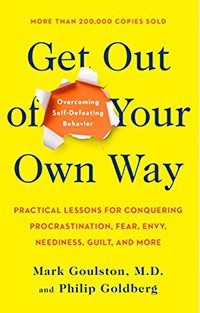
You’re trying to collect data, what happened. In this particular case, I think what happened is, he had been a estranged from his wife, and then there was a restraining order after him. Then, he was kicked out of his apartment or something. It was one negative thing after another thing. There he was with a gun to his head.
There’s a lead negotiator getting information from the backup negotiator. The backup negotiator was someone who had gone to one of my training’s. One of the techniques that the backup negotiator said to the lead negotiator was to say to this person … So imagine you’re that person, Stephan. You’re in that thing, and life is just terrible. You don’t know if you want to kill yourself, but you don’t see anyone out.
The technique that they use was something that I call the magic paradox. What the lead negotiator told the backup negotiator, who’s trained, say to this guy, “I’ll bet you feel right now that nobody knows what it’s like to be you and nobody cares.” What happened is he put into words exactly what the person holding the gun was thinking, and what the guy said was, “Yeah, you’re right. Nobody knows what I’m going through and nobody gives a flying [F].”
What happened is that person felt understood. So it’s a magic paradox because you’re saying I’ll bet you feel nobody understands. So that started to make a relationship. Then the next thing I believe the person said, “I bet your feeling nobody knows what it’s like that when you try things everyday, you just make things worse. This is kind of the only thing you’re left with. Isn’t that true?”
They added up the background data and he was able to say, “Yeah, you’re right. Everything I do blows up in my face. Nobody knows, and nobody gives a [such and such].” If you could imagine if you’re that person, you’re leaning into the conversation. It’s a paradox because the person is basically saying I understand that you feel that nobody knows what it’s like for you right now.
You’re giving them things that they can say yes to. Again, going back to the mirror neuron gap, what’s happening is this is a person who is, completely feels cut off by the world and nobody cares about him and nobody understands him.
In a paradoxical way, you’re demonstrating an understanding and caring. He’s leaning towards that.
That’s just kind of a small kind of thing. But, maybe in your mind’s eye, you could see how something like that would work.
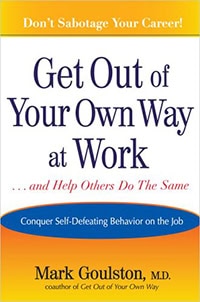
I want to give a tip to help geeks’ lives be better. Here’s something all of you should understand. One of the reasons you often don’t get a seat at the strategy table … If you’re a geek, you make CEOs who don’t understand technology but want to use it, you make them feel stupid. They don’t like anyone that makes them feel stupid. They just want technology to work. They want it to be simple. If it breaks down, they want it fixed. But there’s more than a few companies in which the board of directors, it’s a public company, does not know the name of the Chief Technology Officer because to them you’re just a widget. You’re just connected to technology.
Here’s what you need to know if you’re a geek. What your passionate about, which is how and why technology works, the majority of the world doesn’t care about. What they want is the bottom line, will this do what it’s supposed to do, and can someone who’s stupid about technology like me, use it?
I give these talks on the secret of Steve Jobs, how do you create ‘gotta have it’. What Steve Jobs realized, and in my talk I talk about, when he discovered the graphically user interface at Xerox Park, and there’s a video that I show of him, when he discovered that, that’s when he went from hustler to visionary. Because when he saw that people could use a mouse and play with the screen instead of typing in stuff, what he realized is this is going to make technology simple. If we can make it reliable instead of complicated, if we make it beautiful, because he was into calligraphy, if we can make something that is formerly ugly beautiful, something that’s complicated, simple, and something that’s unreliable, reliable, everybody who just wants to use technology will be a pack through our door and that’s exactly what happened.
So you have to realize if you want people … don’t expect people to be passionate about how and why technology works. They just want to bottom line. When you go meet with business types who only want that bottom line, when you’re with ducks, quack like a duck. Don’t use any jargon.
I wrote a controversial article. You can pick it up for CIO Magazine, and it got a lot of controversy which they liked. Which was How to Avoid Bumping Heads. It’s how CIO’s can talk to business managers. What I basically said is when you’re with them, you’ve got to talk like a business person. As soon as you start putting in technological terms, they will nod from the neck up because they don’t want to admit they don’t understand or care about a word you’re saying. They don’t want to demonstrate how ignorant they feel. What they’re going to do is they’re going to see you as a non person. They’re going to marginalize you.
Learn how to talk like a business person. Learn to be overly sensitive to when you’re using jargon.
I think one of the reasons Just Listen did so well is because when you read it most people feel it doesn’t sound like psycho-babble. It doesn’t sound like psychological mush mouth. You can tell me, Stephan, I don’t think I’ve, hopefully in this conversation which I haven’t shut up about, which is not the best thing for a guy who wrote a book about listening-
Learn how to talk like a business person. Learn to be overly sensitive to when you’re using jargon.
No, I’ve invited you to come and talk. No, it’s good.
There you go, there you go. Good.
What I hope I’ve been is that I’ve used regular language, other than mirror neurons because I’m kind of passionate about neuropsychology. I hope people find that fascinating as I do. I hope that I haven’t used a lot of psychobabble. If you’re going to write something, and when you write your next book, if it’s going to be geared towards this audience, you can get away with some jargon.
But, the point is if your trying to help them transition into a three-dimensional life from a one-dimensional life, I think there needs to be a way in which you gently ease them out of the world of totally thinking, talking, and looking at the world as a technologist. Looking at it more like a kind of a human being instead of a human doing technology.
Human being instead of a human doer, remember that.
So, this reminds me of Tony Robbins would talk about mirroring and matching with regards to NLP, Neuro-Linguistic Programming, and how when somebody is a really fast talker that you should mirror and match that and speak in at a similar sort of pace because otherwise, they’re going to think you’re kind of dumb, or that you are just not on the same wavelength. Whereas somebody who is speaking very slowly, and deliberately, you want to match that pace and mirror that sort of tonality. Otherwise, again, they’re going to feel that disconnect, that mirror neuron gap.
It’s a good way to frame up that Tony Robbins teaching with a new kind of terminology. I like it.

Well, here’s one of the issues I have with NLP. For those listening who don’t know it, it means that a lot of people process either in visual, auditory, or kinesthetic channels. When someone is saying I see the point you’re trying to make, you want to match them in terms of … Well, why don’t we look at it this way? You don’t want to match them or mismatch them by saying “Well, I hear your point.” The idea is you match one to the other.
Now the issue that I have with NLP, to me what’s really important are the values that drive you. There’s more than a few NLP people who like mastering this trick of matching to matching. More than a few of them like using it to maneuver people. If you’re key is to bring value and be of service, use NLP.
But, there are too many people I know who just feel like they discovered a magic trick. One of the reason’s that I like noticing the adverbs, adjectives, and what-not, not just because I came up with it, what you’re really noticing is the in road to deeper emotions. Then if you give them away to talk more, you’ll notice them revealing more of themselves. The key is, this is what I try to practice, if you can get people to reveal what most deeply matters to them, what their deepest dream is, and what their deepest fear is, and then care about them, and being of service to them when they’re there, that’s what I’m in favor of.
One of the things I recommend to people is to get people to open up as much as they can. You’re there to be of service to them. If it means you don’t get the business, but you’ve developed a great network of people, you’re then able to say, “I know someone who can help you with what you just brought up to me.”
In fact, there’s a number of people I’ve met, and they’ve told me that I’d become kind of a, not a legend, but a little of a cult figure because sometimes I’ve driven two hours to meet someone. When they opened up, it was clear I could sell them on something, and I said, “From what I’ve heard you say, you need me; but you need these three other things first. You need to prioritize those and I don’t do those. But, if you don’t have people who do it, I can recommend three people. Then, get around to me.”
What would happen is if you have someone hammering you, like a sales manager, saying, “Did you close?” “No, I made a referral.” You’re going to have to have an enlightened sales manager. But, the trust that it builds is amazing. People will say, “When’s the last time someone drove two hours, and they could’ve sold you something; and they told you needed two other things, or three other things first?”
Get people to open up as much as they can. You’re there to be of service to them.
Why I love that is I have a great network of experts, including Stephan Spencer. When I can say to someone, what you really need, and I think I’ve even mentioned you, in some of the gatherings we go to is, “Stephan is a genius in this SEO stuff! You need to get that done.”
What happens is I’m out of having to be a slick salesperson. I’m serving them, which is kind of my higher purpose. Then it allows me to develop a relationship with Stephan Spencer so that he says, ” Why don’t you come on my podcast? I’m developing some.”
You build a whole network of people really helping each other. The focus is on let’s put our client, or customer’s needs, in the center, and take care of them. Then we’ll refer each other around when they need that. That’s my approach to life. That’s really enabled me to avoid doing something that I’ve never been good at, which is manipulating and maneuvering people to sell them on something, when they need something else more.
It’s all about having their best interest at heart, for sure.
Let’s wrap this interview up with one final question, and it’s a big one. How does one self-manage their own anger, their own depression, their own PTSD, if they have that, something that’s really quite a big potential land mine that they have to navigate around? How do they operate in the world with anger, depression, and so forth, without it debilitating them? Without it destroying relationships, and hurting their own psychology?
People who are moody feel disappointed in someone else, or something, or themselves, and they can’t let go of it.
Well, I give a couple of things. I just wrote a blog at Huffington Post, I think it’s up there in psychology today. It’s called Overcoming Garden Variety Moodiness. So this may not seem like a huge thing, but there’s more moodiness than there are mood disorders. You could apply this to mood disorders.
What I realized about people who are moody, tell me if you think this is emphatically understanding them, I think that people who are moody feel disappointed in someone else, or something, or themselves, and they can’t let go of it, which is what causes them to be moody. Hopefully makes sense and feels right.
Here’s what I realized. You can’t feel disappointed and grateful at the same time. Being disappointed is better than saying, “Who or what am I frustrated about?” Because when you say I’m frustrated, it tends to trigger retaliation. “Well, I’m frustrated with so and so,” or “I’m frustrated with myself, so I’m going to beat up myself.”
Frustration is not a very helpful feeling. If you can dig down and say, “What am I really disappointed about? Others, or me, or something?” Then you identify that.
One of the things that I do, if you have mentors, and I’ve had six mentors, all of them have died. So I have something called the “Dead Mentors Support Group.” I imagine them, and how much they cared about me. I imagine, even now, just some of the incidents in where they stepped into my life. They believe in me when I didn’t. Just imagining them … If you’re listening closely, the tempo of my voice has softened because even in this conversation I’m picturing their faces, like I get very emotional. I’m remembering that they cared about me. I’m remembering that they believed in me. I’m remembering that it was a blessing that I had them. If I was feeling disappointed about something, before I even gave this example; I have no idea what that’s about.
If you can remember people that you’re grateful to, if you’re fortunate enough to have them living, go thank them. Now the other thing to do … I’m a psychiatrist. I used to be a clinical psychiatrist, used to prescribe medication. My understanding of neurotransmitters, which underlies antidepressants, is that dopamine, which is a natural neurotransmitter is associated with pleasure. Often we’re drawn to activities that are pleasurable because they trigger a release of dopamine.

If you’re feeling down, there’s a good chance that you’re having trouble accessing your dopamine. You can find a list of natural sources of that. Exercising increases dopamine. Other activities increase dopamine. There are natural dopamine supplements; there’s something called L-Tyrosine, which is a breakdown product. If you go start taking dopamine, there’s a good chance you will reverse that. Certain antidepressants work on dopamine.
The other neurotransmitter that’s, associated with holding on to things, is called serotonin. When people are low in … That’s a natural neurotransmitter. When people are low in serotonin, they dwell on things. They can’t let go of things. Instead of being disciplined about something, which is calmer, they ruminate about it. Search out the natural sources of serotonin, which also includes exercise and a number of activities. You can also get supplements that increase serotonin. If it’s something that’s deeper, the antidepressants work on either dopamine or serotonin.
Look, we could go on forever, and we’ve already gone past what was reasonable, but I hope those help give people some ideas and some approaches when they’re feeling down.
That’s great. Well, thank you so much, Mark, for sharing your wisdom and insights into our psychology and interpersonal relationships, and how to really build rapport and goodwill with the people that we care about. Powerful stuff.
If some listeners want to connect with you, and maybe read more of your stuff, or hire you? I don’t know if available to be hired for help with stuff. How would they reach you?
Go to the Goulstongroup.com. If you go to the front page, there’s a button that has free resources. You put in your first name and your email, and you’ll receive an email that allows you certain free resources; including one of the videos of my “Steve Jobs Talk” that I gave at a digital media conference. They’ll also be some other helpful exclusive documents. Plus, you’ll get a link to a campaign I’ve started on Patreon called Heal the World One Conversation at a Time. What we’re doing there is collecting what we call ‘conversation catalysts’, where I speak for another person to you. Then you give it to that person, and say “is this what you’re trying to tell me?” Often, I’m already told, that it’s a catalyst for a very good conversation. That’s why we’re calling it Heal the World One Conversation at a Time.
I think that’s the best way to reach me and hire me. Something I will also say is I’ve recently thrilled, I’ve just partnered with someone who is going to be my new president. Her name is Gwen Walsh. If you look up TechEdge, that’s her company, which eventually she’s going to fold into the Goulston Group. She is an amazing CIO who has worked in the corporate world. When you read the testimonials of people that have worked with her, and as I got to know her, she is your poster child … In fact, you should interview her … for being a three dimensional balanced CIO. She doesn’t talk like a geek. You’ll have to have her on.
Gwen Walsh, she’s my president. I’m so honored that she’s joined me.
All right, well thank you Mark, and thank you, listeners. We’ll catch you on another episode of the Get Yourself Optimized.
Important Links
Connect with Mark Goulston
Company
People
Books
Articles
Video






